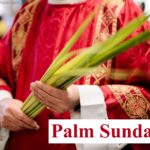
Catholics commemorate the Last Supper on the Thursday before Easter, known as Holy Thursday or Maundy Thursday.
Maundy is derived from the Latin word for “command”, referring to the new Commandment that Jesus gave his disciples.
Jesus was celebrating the Jewish Passover with his Apostles at what would be his final meal when He instituted the Sacrament of Eucharist by changing the bread and wine into his Body and Blood.
He also established the priesthood and washed the feet of his closest followers before going into the Garden of Gethsemane where he would be arrested.
Traditionally, on the morning of Holy Thursday the bishop of each diocese celebrates a Chrism Mass where the holy oils that will be used during the year are blessed and priests of the diocese renew their vows.
Holy Thursday is the first of three sacred days that make up the Paschal Triduum. Along with Good Friday and Holy Saturday it brings Lent to a close.
Holy Thursday is the first day of the Easter Triduum:
Entering into what Jesus experienced for three days:
One sacred liturgy celebrated over three holy days:
When the hour came, He took his place at table with the apostles. He said to them, “I have eagerly desired to eat this Passover with you before I suffer, for, I tell you, I shall not eat it [again] until there is fulfillment in the kingdom of God.” Then He took a cup, gave thanks, and said, “Take this and share it among yourselves; for I tell you [that] from this time on I shall not drink of the fruit of the vine until the kingdom of God comes.” Then He took the bread, said the blessing, broke it, and gave it to them, saying, “This is my body, which will be given for you; do this in memory of Me.” And likewise the cup after they had eaten, saying, “This cup is the new covenant in my blood, which will be shed for you.”
Luke 22: 14-20
Signifying the unity in the Church and the power of Jesus:
A Mass celebrated only one time each year in each diocese:
So, while they are eating, Jesus rises from the table and begins to wash the disciples’ feet. At first Peter resists, then he understands and accepts. We too are asked to understand: the first thing the disciple must do is to prepare himself to listen to the Lord, opening his heart to accept the initiative of his love. Only then will he be invited, in turn, to do what the Teacher did. He too must be committed to “washing the feet” of his brothers and sisters, expressing in gestures of mutual service that love which is the synthesis of the whole Gospel. Also during the Supper, knowing that his “hour” had now come, Jesus blesses and breaks the bread, then gives it to the Apostles saying: “This is my body”; He does the same with the cup: “This is my blood”. And He commands them: “Do this in remembrance of Me”. Truly this is the witness of love taken “to the end”. Jesus gives Himself as food to his disciples to become one with them. Once again the “lesson” emerges that we must learn: the first thing to do is to open our hearts to welcoming the love of Christ. It is his initiative: it is his love that enables us, in turn, to love our brethren. Therefore, the washing of the feet and the sacrament of the Eucharist: two expressions of one and the same mystery of love entrusted to the disciples, so that, Jesus says, “as I have done… so also must you do”.
Pope John Paul II, Mass of the Lord’s Supper, April 17, 2003
An act of service and a memorial feast:
Jesus is the Lamb of God:
The holy priesthood, the Eucharist, and a new Commandment:
God shows that He wants to be close to us:
A symbolic action and an absurd gesture:
Following Jesus and seeing Him in one another:
Jesus’ obedience to his mother and legal father fulfills the fourth Commandment perfectly and was the temporal image of his filial obedience to his Father in Heaven. The everyday obedience of Jesus to Joseph and Mary both announced and anticipated the obedience of Holy Thursday: “Not my will. . .” The obedience of Christ in the daily routine of his hidden life was already inaugurating his work of restoring what the disobedience of Adam had destroyed.
Catechism of the Catholic Church 532
Jesus’ ultimate surrender of his life:
The Truth, Goodness, and Beauty of the Catholic Church
Dare to do great things:
Share this page with friends and family to start a conversation about your faith.
Don’t miss a post. Learn more about the Catholic Church and strengthen your Catholic faith.
Find more Fiercely Catholic video issues here.
Subscribe here.


